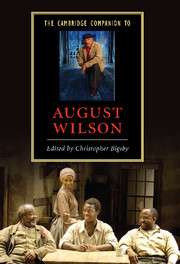Book contents
- Frontmatter
- 1 August Wilson: the ground on which he stood
- 2 Been here and gone
- 3 August Wilson’s relationship to black theatre: community, aesthetics, history and race
- 4 Music and mythology in August Wilson’s plays
- 5 Gem of the Ocean and the redemptive power of history
- 6 Joe Turner’s Come and Gone
- 7 Ma Rainey’s Black Bottom: cutting the historical record, dramatizing a blues CD
- 8 A piano and its history: family and transcending family
- 9 The tragedy of Seven Guitars
- 10 Safe at home?: August Wilson’s Fences
- 11 Two Trains Running: blood on the tracks
- 12 Jitney, folklore and responsibility
- 13 King Hedley II: in the midst of all this death
- 14 Radio Golf: the courage of his convictions - survival, success and spirituality
- 15 Critics on August Wilson
- 16 An interview with August Wilson
- Index
9 - The tragedy of Seven Guitars
Published online by Cambridge University Press: 28 January 2008
- Frontmatter
- 1 August Wilson: the ground on which he stood
- 2 Been here and gone
- 3 August Wilson’s relationship to black theatre: community, aesthetics, history and race
- 4 Music and mythology in August Wilson’s plays
- 5 Gem of the Ocean and the redemptive power of history
- 6 Joe Turner’s Come and Gone
- 7 Ma Rainey’s Black Bottom: cutting the historical record, dramatizing a blues CD
- 8 A piano and its history: family and transcending family
- 9 The tragedy of Seven Guitars
- 10 Safe at home?: August Wilson’s Fences
- 11 Two Trains Running: blood on the tracks
- 12 Jitney, folklore and responsibility
- 13 King Hedley II: in the midst of all this death
- 14 Radio Golf: the courage of his convictions - survival, success and spirituality
- 15 Critics on August Wilson
- 16 An interview with August Wilson
- Index
Summary
August Wilson described the creative process that produced Seven Guitars (1995) in a 1996 interview with Jan Breslauer. Fundamentally, he said, 'the basis is character'. He suggested that the characters occurred to him first in the form of a speech, or a turn of phrase, noting that although 'they're all different aspects of my personality', they are all also 'voices of the black community.' He described his creative work as analogous to that of a collagist, piecing the voices together to make a whole. In the case of Seven Guitars, this is particularly important, for, as he told Carol Rosen, Wilson conceived of the seven characters in the play as instruments themselves: 'They are the seven guitars. They each have their individual voices and their individual characters. And if they're the guitars, then I guess I'm the orchestra.' It took Wilson some time to arrive at the design for the play. He explained later that it began its life in his imagination with four characters, none of them women, set in a turpentine camp in Georgia. Lacking any knowledge of turpentine camps, he had the idea of moving the play to Chicago, 'the natural place for a bluesman', and found that he was 'writing a play set in the 1940's that was supposed to be somehow representative of black American life, and I didn't have any women in there. And I knew that wasn't going to work.'
In the play as Wilson finally wrote it, there are seven characters, the blues musician Floyd Barton, his two sidemen, or supporting musicians, drummer Red Carter and harmonica player Canewell, Canewell's girlfriend Vera, and three people who live in Vera's house: Louise, a middle-aged single woman whose beautiful young niece Ruby comes to stay with her, and King Hedley, a West Indian who lives in his dreams.
- Type
- Chapter
- Information
- The Cambridge Companion to August Wilson , pp. 124 - 134Publisher: Cambridge University PressPrint publication year: 2007

